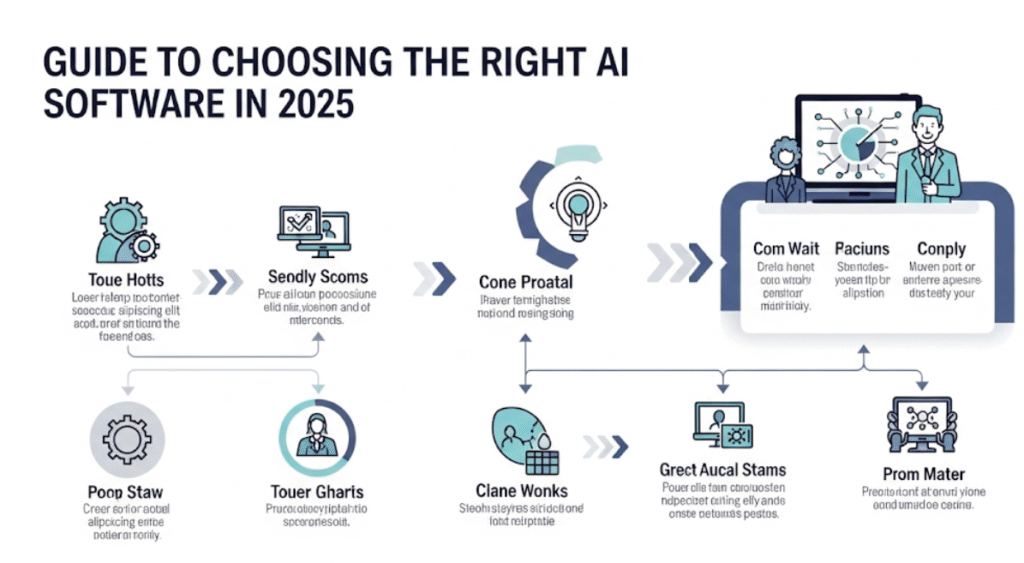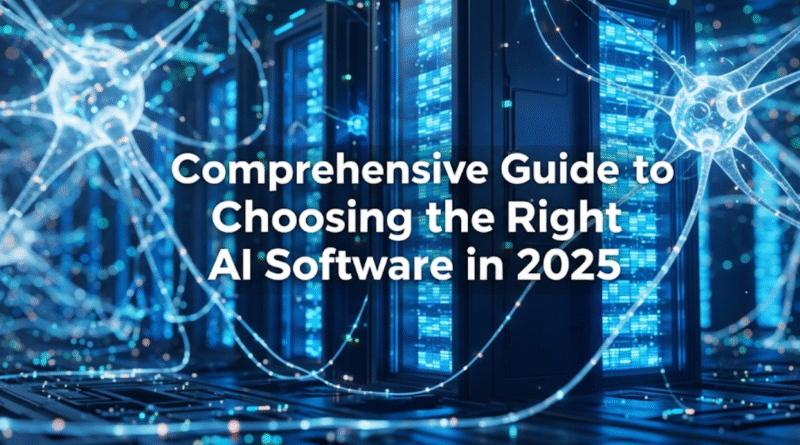Comprehensive Guide to Choosing the Right AI Software in 2025
We are in the throes of an artificial intelligence (AI) revolution that is dramatically changing how businesses operate in every sector. Businesses from small startups to the Fortune 500 are deploying AI software that saves time, reduces costs, and opens new strategic possibilities.
The problem is — there are hundreds of AI tools on the market and finding the right software for your use case can be next to impossible! Pick the wrong solution and you may end up wasting thousands of dollars, falling behind in the race to develop better solutions from your competitors.
This guide aims to help you make sense of all the jargon and offer a clear path toward selecting AI software that applies to your case. You will learn the critical functionality to pay attention to, mistakes to avoid and how to implement AI based on actual experience.
Here’s What AI Software Looks Like in 2025
The Evolution of AI Tools
In reality, AI software in 2025 shares no resemblance with the rudimentary automation tools of just five years prior. Today AI solutions write marketing copy, analyze intricate patterns in data, generate beautiful visualizations and even code entire applications. Technology has never been more user friendly, less expensive and more powerful.
There have been three major evolutions underpinning today’s AI environment:
- No-Code AI Platforms — You don’t need programming to use advanced AI tools
- Integration-First Design — Integrate easily with any platform
- Specialized Industry Solutions — AI tools are now working for various industries with specialized features for specific sectors (Healthcare, Banking etc) with excellent industry features and integrated data flows
Types of AI Software Available
AI Software Market Segmentation:
Content Creation AI
- AI blog, email and social media assistants
- Image generators for marketing materials
- Video production tools for content creators
Business Intelligence AI
- Predictive analytics for sales forecasting
- Customer behavior analysis tools
- Financial risk assessment platforms
Automation AI
- Chatbots for customer service
- Workflow automation systems
- Document processing solutions
Industry-Specific AI
- Healthcare diagnostic tools
- Legal document analysis
- Manufacturing quality control systems
Key Features That Actually Matter
Performance and Accuracy Metrics
Favor performance metrics that can be quantified over marketing hype when considering AI software. The most important metrics include:
Accuracy Rates
- Software should be approximately 90% efficient at its core functions
- Insist on seeing case studies that demonstrate real-life performance data
- Whenever possible, test the software with your own data
Processing Speed
- Test the software performance with common workloads
- Review peak usage times and any performance degradation
- Realistically account for any latency from cloud-based processing
Learning Capabilities
- The software should improve with more data over time
- Check that it can adapt to your particular business environment
- Look at turnaround time on feedback and corrections
User Interface and Accessibility
The most powerful AI software combines advanced features with simple and intuitive interfaces. Key usability factors include:
- Drag-and-drop functionality for building workflows
- Plain English commands, not technical programming
- Easy-to-read visual dashboards
- Mobile compatibility for on-the-go access
- Collaboration features for team-based projects
Integration Capabilities
A business today uses a number of software tools and you want to ensure that your AI solution connects with all of them. Essential integration features include:
| Integration Type | Why it Matters | Examples |
|---|---|---|
| CRM Systems | Automatic customer data transfer | Salesforce, HubSpot |
| Email Platforms | AI-powered campaign management | Mailchimp, Constant Contact |
| Cloud Storage | Quick file upload and sharing | Google Drive, Dropbox |
| Analytics Tools | Deep-level data analysis | Google Analytics, Tableau |
| Communication Apps | Smooth team collaboration | Slack, Microsoft Teams |
Budget Planning for AI Software
Pricing Models Explained
AI software companies employ different kinds of pricing structures, each with its own pros and cons:
Subscription-Based Pricing
- Monthly or annual payments
- Predictable costs for budget planning
- Usually comes with updates and support
- Average cost: $20-$500 per user/month
Usage-Based Pricing
- Pay only for what you consume
- Best for companies with unpredictable workload
- May get costly with regular use
- Common for API-based services
One-Time License Fees
- Large upfront payment
- Less expensive over the long term for frequent users
- Updates may cost extra
- Mostly ineffective in modern AI software
Freemium Models
- Basic features available free
- Premium features require payment
- Good for testing before commitment
- Often limited in functionality
Hidden Costs to Consider
In addition to the stated price, consider these costs:
Training and Onboarding
- Staff training programs: $2,000-$10,000
- Consultant fees for setup: $5,000-$25,000
- Lost productivity during transition: Variable
Integration and Customization
- API development costs: $3,000-$15,000
- Custom feature development: $10,000-$50,000
- Third-party connector fees: $100-$1,000 monthly
Ongoing Maintenance
- Technical support contracts: 15-25% of the license cost
- Regular software updates: Often included
- Data storage costs: $0.02 — $0.10 / GB per month
Industry-Specific Considerations
Healthcare AI Software
AI tools that comply with regulatory requirements while improving patient outcomes are essential for healthcare organizations. Key considerations include:
Compliance Requirements
- HIPAA compliance for protecting patient data
- FDA approval for diagnostic tools
- Clinical validation studies and documentation
Essential Features
- Electronic health record (EHR) integration
- Medical imaging analysis capabilities
- Drug interaction checking systems
- Patient risk assessment tools
Top Use Cases
- Radiology image interpretation
- Drug discovery and development
- Clinical decision support systems
- Patient scheduling optimization
Retail and E-commerce AI
AI in retail is used for creating personalized customer experiences, inventory management and sales optimization. Critical features include:
Customer Analytics
- Purchase behavior prediction
- Personalized product recommendations
- Customer lifetime value calculations
- Churn risk identification
Inventory Management
- Demand forecasting algorithms
- Automated reordering systems
- Seasonal trend analysis
- Supply chain optimization
Marketing Automation
- Dynamic pricing strategies
- Targeted email campaigns
- Social media content generation
- Customer segmentation tools
Manufacturing AI Solutions
Manufacturing companies use AI for quality control, predictive maintenance and process optimization:
Quality Control Systems
- Visual inspection automation
- Defect detection and classification
- Statistical process control
- Compliance reporting tools
Predictive Maintenance
- Equipment failure prediction
- Maintenance scheduling optimization
- Parts replacement forecasting
- Downtime cost analysis
Security and Compliance Factors
Data Protection Standards
Security is paramount since the software handles sensitive business information. Essential security features include:
Encryption Standards
- AES-256 encryption for data at rest
- TLS 1.3 for data in transit
- End-to-end encryption for communications
- Secure key management systems
Access Control Measures
- Multi-factor authentication (MFA)
- Role-based access permissions
- Regular access reviews and audits
- Single sign-on (SSO) integration
Compliance Certifications
- SOC 2 Type II reports
- ISO 27001 certification
- GDPR compliance documentation
- Industry-specific certifications
Data Privacy Considerations
Choose AI software that prioritizes data protection as privacy regulation laws become more stringent globally:
- Data Minimization — Collects only the data it needs
- Purpose Limitation — Uses data only for stated purposes
- Retention Policies — Automatically removes old data
- User Rights — Facilitates data access & deletion requests
- Cross-Border Transfers — Compliant with international data laws
Implementation Strategy That Works
Phase 1: Pilot Program Approach
Start small to minimize risks and maximize learnings.
Select a Limited Scope
- Test one department or process first
- Establish tangible, quantifiable objectives for the initial phase
- Set a deadline of 3–6 months for evaluation
Define Key Stakeholders and Success Metrics
Key Success Factors:
- Executive sponsorship and support
- Establish a project team with defined roles and responsibilities
- Regular progress reviews and adjustments
- Transparent discussion of challenges and successes
Phase 2: Training and Change Management
Successful AI implementation requires more than just technology.
Training Program Essentials
- Hands-on workshops for end users
- Documentation and reference materials
- Ongoing support and troubleshooting resources
- Regular skill assessments and updates
Change Management Best Practices
- Clear communication of benefits and changes
- Address concerns and resistance proactively
- Celebrate quick wins and success stories
- Provide continuous feedback channels
Phase 3: Scaling and Optimization
Strategically scale your pilot success across the organization.
Gradual Rollout Strategy
- Add departments or processes incrementally
- Monitor performance and adoption rates across users
- Adapt training and support based on learnings
- Maintain focus on business value and ROI
Continuous Improvement Process
- Regular performance reviews and optimizations
- User feedback collection and implementation
- Stay current with software updates and new feature releases
- Benchmark against industry best practices

Common Mistakes That Cost Money
Rushing the Selection Process
One of the biggest mistakes is that many businesses choose AI software prematurely without having well-defined goals and fail to realize if an off-the-shelf solution could have worked just as well.
The Problem
- Inadequate research and comparison shopping
- Focus on features over business impact
- Not accounting for integration and hidden costs
- Skipping proper testing and evaluation phases
The Solution
- Take 2–3 months for thorough evaluation
- Test solutions under real business conditions
- Calculate Total Cost of Ownership (TCO) over 3-5 years
- Involve end users in the selection process
Ignoring Scalability Requirements
While starting small may be wise, planning for growth is essential:
Signs of Poor Scalability Planning
- Software slows down with additional users
- High licensing costs as company grows
- Complex integration requirements over time
- Limited customization options for evolving needs
Scalability Checklist
- ✓ Can handle 10x current user base
- ✓ Maintains performance under high load
- ✓ Flexible pricing that scales with your growth
- ✓ Enterprise features available when needed
- ✓ Supports data integrity when scaled up
Overlooking User Adoption Factors
Without user adoption, even the best AI software will fail.
Common Adoption Barriers
- Complex interfaces that intimidate users
- Inadequate training and support resources
- Resistance to changing established workflows
- Lack of clear value demonstration
Strategies for Better Adoption
- Choose intuitive, user-friendly interfaces
- Invest heavily in training and support
- Identify and empower internal champions
- Demonstrate quick wins and tangible benefits
Future-Proofing Your AI Investment
Technology Trends to Watch
The AI landscape is advancing rapidly. Consider these emerging trends as you make your selection:
Multimodal AI Capabilities
- Software that processes text, image and audio combined
- More natural and flexible user interactions
- Improved context awareness and decision-making capabilities
Edge AI Processing
- Faster response times with local processing
- Reduced reliance on internet connectivity
- Enhanced privacy and security features
Explainable AI Features
- Clear explanations of AI decisions and reasoning
- Compliance with evolving AI governance regulations
- Improved user trust and confidence in AI outputs
Vendor Stability and Support
Choose AI software vendors with proven track records and strong future prospects.
Financial Stability Indicators
- Consistent revenue growth and profitability
- Strong institutional investor backing and funding
- Diverse customer base across industries
- Regular product updates and improvements
Support Quality Factors
- Guaranteed response times for technical support
- Multiple support channels: phone, email and chat
- Comprehensive documentation and training resources
- Active user community and support forums
Measuring Success and ROI
Key Performance Indicators (KPIs)
Measure success using these standard AI software metrics:
Operational Efficiency
- Time saved on routine tasks per week
- Error reduction rates (percentage improvement)
- Process automation levels (tasks automated)
- Employee productivity gains (output per hour)
Financial Impact
- Monthly cost savings from automation ($)
- Revenue increases from improved processes
- Return on investment (ROI) calculations
- Payback period (in months)
User Satisfaction
- Adoption rates across departments
- User satisfaction survey scores
- Training completion rates
- Support ticket volume and resolution time
ROI Calculation Framework
Calculate AI software ROI using this simple framework:
Step 1: Calculate Total Investment
- Software licensing costs
- Implementation and setup fees
- Training and change management costs
- Ongoing maintenance and support fees
Step 2: Identify Quantifiable Benefits
- Labor cost savings from automation
- Increased revenue from improved efficiency
- Reduced errors and associated costs
- Time savings converted to dollar value
Step 3: Calculate ROI
ROI = (Total Benefits — Total Investment) / Total Investment × 100
Step 4: Consider Timeframe
- Calculate ROI for 1, 3 and 5 years
- Account for ongoing benefits and costs
- Factor in potential software upgrades
Frequently Asked Questions
What is the average time for AI software implementation?
Implementation timelines vary widely depending on complexity and scale. Basic AI tools, such as chatbots or content generators can be deployed within 2 to 4 weeks. More complex solutions requiring data integration or custom workflows typically take 8 to 12 weeks. Enterprise-wide implementations across multiple departments can take 6 to 12 months or longer.
What’s the biggest mistake you see businesses making when selecting AI software?
The biggest mistake is choosing features over business outcomes. Many businesses get excited by impressive AI capabilities, yet fail to consider whether these features actually solve their unique challenges or integrate with existing workflows. Always start by defining which problems you want the software to solve.
Should small businesses wait for AI software to become more affordable?
No, waiting creates competitive disadvantage. Many AI tools now offer affordable pricing models specifically for small businesses. The key is to start small, with clearly defined use cases that provide clear ROI, and scale as you prove results and gain more budget.
How can I be sure an AI software vendor is trustworthy?
Look for vendors with transparent pricing, relevant customer testimonials, regular software updates and clear support policies. Check their financial stability, read independent customer reviews, and ask for references from businesses in your industry. Request trial periods to test their claims.
Will AI software replace employees entirely?
Most AI software augments human workers rather than replacing them entirely. While AI might automate routine tasks, it cannot replicate uniquely human skills like creative problem-solving, relationship building, and strategic thinking. The goal should be freeing up staff to focus on higher-value activities.
How do I ensure the AI software doesn’t make costly mistakes?
All AI software can make errors, so look for solutions with high accuracy rates and robust error-handling mechanisms. Ensure the software includes human oversight capabilities, confidence scores for its outputs, and audit trails. Always maintain human review for critical business decisions.
When should we reconsider our AI software choice?
Conduct comprehensive reviews annually while monitoring performance regularly. Technology advances rapidly in AI, so new capabilities and alternatives emerge constantly. However, software switching is expensive and disruptive, so only consider it when benefits clearly outweigh costs.
Making Your Final Decision
In 2025, selecting AI software is about balancing cutting-edge technology with your organization’s unique requirements. Treat this as a transformation program — start with clear objectives, involve all stakeholders, and prioritize user adoption over technical features.
Remember that AI software is a tool, not a magic solution. The businesses that see the most success combine smart technology choices with careful planning, comprehensive training, and ongoing optimization. Focus on solving specific problems and test thoroughly before scaling implementation.
The AI revolution is here, and businesses that embrace it strategically will gain sustainable competitive advantages. By following the strategies outlined in this guide, you’ll be well-positioned to make AI software decisions that deliver lasting business value.
Don’t let fear of making the wrong choice prevent you from moving forward. The bigger risk in 2025 isn’t picking imperfect AI software—it’s falling behind competitors who are already using these tools to transform their operations and serve their customers better.

